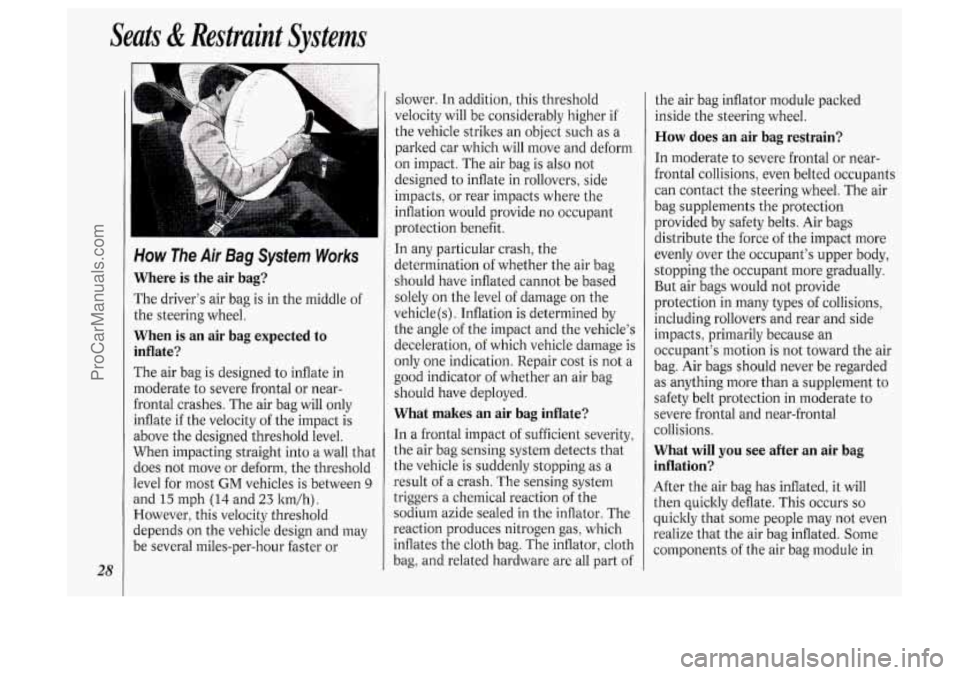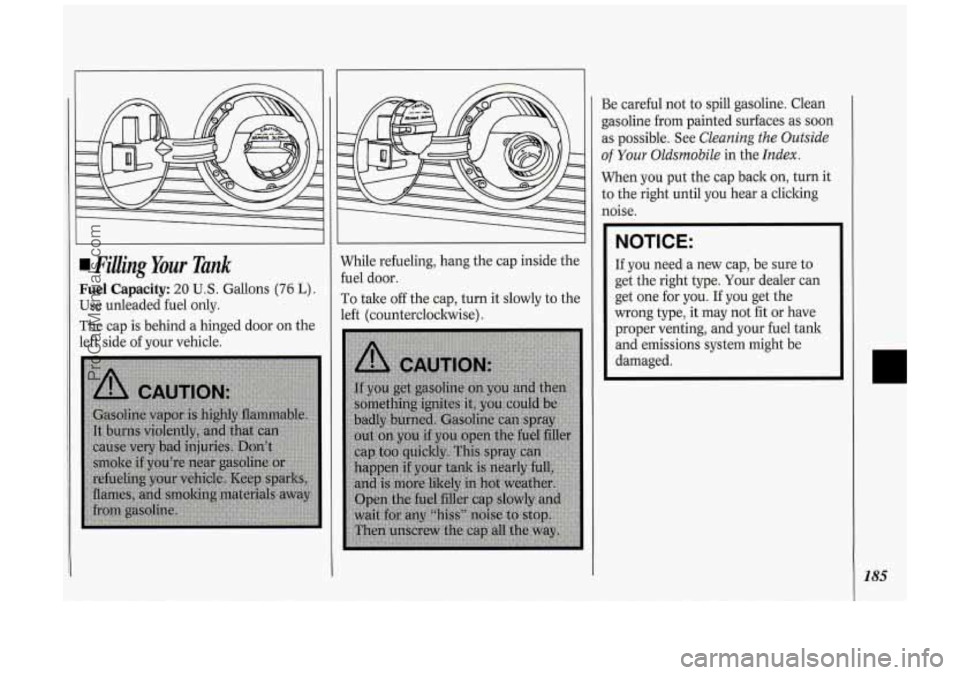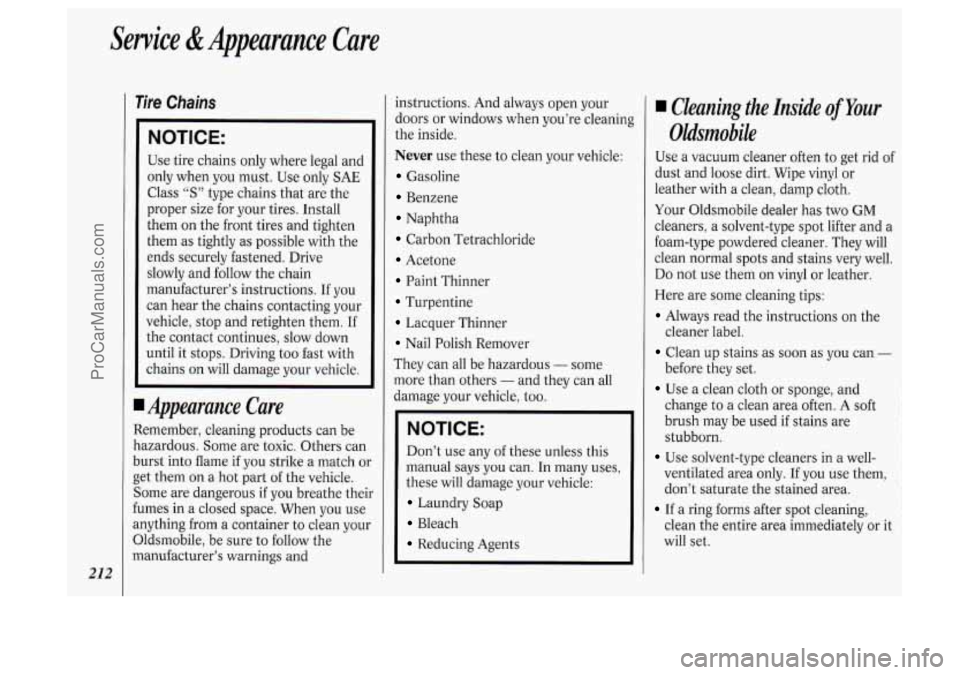gas type OLDSMOBILE SILHOUETTE 1994 Owners Manual
[x] Cancel search | Manufacturer: OLDSMOBILE, Model Year: 1994, Model line: SILHOUETTE, Model: OLDSMOBILE SILHOUETTE 1994Pages: 276, PDF Size: 15.82 MB
Page 30 of 276

Seats & Restraint Systems
28
How The Air Bag System Works
Where is the air bag?
The driver’s air bag is in the middle of
the steering wheel.
When is an air bag expected to
inflate?
The air bag is designed to inflate in
moderate to severe frontal or near-
frontal crashes. The air bag will only
inflate
if the velocity of the impact is
above the designed threshold level.
When impacting straight into a wall that
does not move or deform, the threshold
level for most
GM vehicles is between 9
and 15 mph (14 and 23 ltm/h).
However, this velocity threshold
depends on the vehicle design and may
be several miles-per-hour faster or slower.
In addition, this threshold
velocity will be considerably higher
if
the vehicle strikes an object such as a
parked car which will move and deform
on impact. The air bag is also not
designed to inflate in rollovers, side
impacts, or rear impacts where the
inflation would provide no occupant
protection benefit.
In any particular crash, the
determination of whether the air bag
should have inflated cannot be based
solely on the level of damage on the
vehicle(s)
. Inflation is determined by
the angle
of the impact and the vehicle’s
deceleration, of which vehicle damage is
only one indication. Repair cost is not a
good indicator of whether an air bag
should have deployed.
What makes an air bag inflate?
In a frontal impact of sufficient severity,
the air bag sensing system detects that
the vehicle is suddenly stopping as a
result of a crash. The sensing system
triggers a chemical reaction of the
sodium azide sealed in the inflator. The
reaction produces nitrogen gas, which inflates the cloth bag. The inflator, cloth
bag, and related hardware are all part of the
air bag inflator module packed
inside the steering wheel.
How does an air bag restrain?
In moderate to severe frontal or near-
frontal collisions, even belted occupants
can contact the steering wheel. The air
bag supplements the protection
provided by safety belts. Air bags
distribute the force of the impact more
evenly over the occupant’s upper body,
stopping the occupant more gradually.
But air bags would not provide
protection in many types of collisions,
including rollovers and rear and side
impacts, primarily because an
occupant’s motion is not toward the air
bag. Air bags should never be regarded
as anything more than a supplement to
safety belt protection in moderate to
severe frontal and near-frontal
collisions.
What will you see after an air bag
inflation?
After the air bag has inflated, it will
then quickly deflate. This occurs
so
quicldy that some people may not even
realize that the air bag inflated. Some
components of the air bag module in
ProCarManuals.com
Page 187 of 276

Filling Your Tank
Fuel Capacity: 20 U.S. Gallons (76 L).
Use unleaded fuel only.
The cap is behind a hinged door on the
left side of your vehicle. While
refueling, hang the cap inside the
fuel door.
To take off the cap, turn it slowly to the
left (countercloclnvise)
.
Be careful not to spill gasoline. Clean
gasoline from painted surfaces as soon
as possible. See
Cleaning the Outside
of Your Oldsmobile in the Index.
When you put the cap back on, turn it
to the right until you hear a clicking
noise.
NOTICE:
If you need a new cap, be sure to
get the right type. Your dealer can
get one for you. If you get the
wrong type, it may not fit or have
proper venting, and your fuel tank
and emissions system might be
damaged.
185
ProCarManuals.com
Page 214 of 276

Service &Appearance Cure
212
Tire Chains
NOTICE:
Use tire chains only where legal and
only when you must. Use only SAE
Class
“S” type chains that are the
proper size for your tires. Install
them on the front tires and tighten
them as tightly as possible with the
ends securely fastened. Drive
slowly and follow the chain
manufacturer’s instructions. If you
can hear the chains contacting your
vehicle, stop and retighten them,
If
the contact continues, slow down
until it stops. Driving too fast with
chains on will damage your vehicle.
Appearance Care
Remember, cleaning products can be
hazardous. Some are toxic. Others can
burst into flame if you strike
a match or
get them on a hot part
of the vehicle.
Some are dangerous
if you breathe their
fumes in a closed space. When you use
anything from a container to clean your
Oldsmobile, be sure to follow the
manufacturer’s warnings and instructions.
And always open your
doors or windows when you’re cleanin,
the inside.
Never use these to clean your vehicle:
Gasoline
Benzene
Naphtha
Carbon Tetrachloride
Acetone
Paint Thinner
Turpentine
Lacquer Thinner
Nail Polish Remover
They can all be hazardous
- some
more than others
- and they can all
damage your vehicle, too.
NOTICE:
Don’t use any of these unless this
manual says you can. In many uses,
these will damage
your vehicle:
Laundry Soap
Bleach
Reducing Agents
Cleaning the Inside of Your
Oldsmobile
Use a vacuum cleaner often to get rid of
dust and loose dirt. Wipe vinyl or
leather with a clean, damp cloth.
Your Oldsmobile dealer has two
GM
cleaners, a solvent-type spot lifter and a
foam-type powdered cleaner. They will
clean normal spots and stains very well.
Do not use them on vinyl or leather.
Here are some cleaning tips:
Always read the instructions on the
cleaner label.
Clean up stains as soon as you can - I
before they set.
Use a clean cloth or sponge, and
change to
a clean area often. A soft
brush may be used
if stains are
stubborn.
Use solvent-type cleaners in a well-
ventilated area only. If you use them,
don’t saturate the stained area.
If a ring forms after spot cleaning,
clean the entire area immediately or it
will set.
ProCarManuals.com
Page 241 of 276

6. Transaxle Service - Change both
the fluid and filter every
15,000 miles
(25 000 ltm) if the vehicle is mainly
driven under one or more of these
conditions:
In heavy city traffic where the
outside temperature regularly
reaches
90°F (32°C) or higher.
In hilly or mountainous terrain.
When doing frequent trailer towing.
Uses such as found in taxi, police
car or delivery service.
If you do not use your vehicle under
any of these conditions, change both
the
fluid and filter every 100,000 miles
(166 000 ltm) .
7. Spark Plug Replacement::' -
Replace spark plugs with the proper
type. See
Replacement Parts in the
Index.
8. Spark Plug Wire Inspection''-
Inspect for burns, cracks or other
damage. Check the boot fit at the
distributor or coils and at the spark
plugs. Replace wires
as needed.
9. Exhaust Gas Recirculation (EGR)
System 1nspection':t
- Conduct
the
EGR system service as described
in the service manual.
To purchase a
service manual, see
Service
Publications
in the Index.
IO. Air Cleaner Filter Replacement+-
Replace every 30,000 miles
(50 000 ltm) or more often under
dusty conditions.
Ask your dealer
for the proper replacement intervals
for your driving conditions.
11. Air Cleaner Inspection''? - Inspect
all hoses and ducts for proper
hookup. Make sure the valve works
properly.
1nspection';:t - Inspect fuel tank,
cap and lines for damage
or leaks.
Inspect fuel cap gasket for an even
filler neck imprint or any damage.
Replace parts as needed. Periodic
replacement of the fuel filter
is not
required.
12. Fuel Tank, Cap and Lines
13. Engine Timing and Distributor
Check
(3100 Code D engine
only)'xt
- Adjust the timing to the
underhood label specifications.
Inspect the inside and outside
of the
distributor cap and rotor for cracks,
carbon tracking and corrosion.
Clean or replace as needed.
NOTE: To determine your engine's
displacement and code, see
Engine
Identification
in the Index.
': = An Enzission Control Service.
t = The U.S. Environmental Protection Agency
or the California Air Resources Boa1.d has
determined that the failure
to pelform this
maintenance item will
not nullify the
emission warranty
or limit recall liability
prior
to fhe completion of ~~ehicle useful life.
General
Motors: however, urges that all
recornmended maintenance services be
performed at the indicated intervals and the
maintenance be recorded
in "Section E:
Maintenance Record."
239
ProCarManuals.com